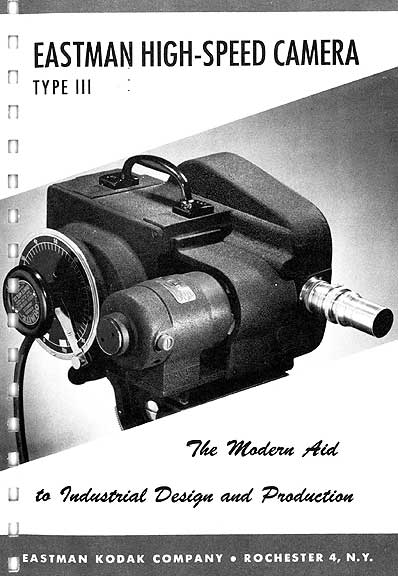
 EASTMAN
HIGHSPEED CAMERA TYPE III IN USE
Setup for investigating the differential behavior of red-hot steel when quenched in oil and water. Camera Speed 1000 frames per second "Time Magnification" approximately 65 Diaphragm Setting f/4 Film CineKodak SuperXX Film Illumination Four R2 Lamps at about 2 feet from the subject This high speed motion picture investigation revealed valuable information on scale forming and scale shedding, and on the formation and behavior of air bubbles. EASTMAN
HIGH SPEED CAMERA TYPE III
for High Speed Motion Pictures The Modern Aid to Industrial Design and Production Need for Motion Analysis Improvements in design and production methods form the basis of industrial progress. Many industrial products and practically all operations in their manufacture involve rapid movements which cannot be seen or analyzed by the human eye. A complete knowledge of what occurs during a given movement, however, is often a prerequisite for better design and more efficient production methods. Today, complete information on the essential movement of the product itself and the machines that make it is more important than ever before. Most modern products and their parts are held close to minimal strength requirements in the interest of minimum size and weight and the conservation of raw material. The production machinery itself, is used at ever greater speeds for maximum output. The need of an instrument capable of revealing important phases of rapid motion is readily apparent, especially one which does not exert any mechanical influence, as strain gauges, extensometers, or other devices some times do. Note: High speed motion pictures have a picture frequency usually in excess of several hundred frames a second, and should not be confused with "slow motion" pictures, which are usually made at 64 and 128 frames per second. Aids for Motion Analysis The Electrical Type Various devices are employed to overcome the in ability of the eye to perceive rapid movements with sufficient clarity for detailed observation. The Stroboscope, for example, owing to its simplicity in operation, has found relatively wide application. Its use, however, is more or less limited to the observation of periodic and constant motions of considerable duration. The Stroboscope and similar devices fall to provide a record which can be studied at any time and by a single person or a group. High-speed photographs can be obtained by a single flash-discharge of extremely short duration (1/5000 to 1/1,000,000 second). The flash, which not only provides the illumination but also controls the exposure duration, has been used successfully to obtain a visible record of an action at a particular instant. This method, however, does not provide any information as to what went on before and after the instant recorded. Because of the very short exposure, the flash must be controlled so that it occurs at exactly the correct instant. A number of flash-discharges at extremely brief intervals will reveal information about the subject's movements over a comparatively longer period of time. Such multiple exposures on a single film are useful for determining the speed of the object's motion by comparing the displacement when the flash-interval time is known. In many cases, the detailed study of the behavior of a moving part is made difficult, if not impossible, by the overlapping of parts of' the images recorded. This latter difficulty has been overcome by making flash-discharge pictures on motionpicture film advancing at a continuous speed. Such a method has provided valuable information on the movement and behavior of objects at extremely high speeds, such as bullets in flight, where fractions of a 1/100,000 second are essential to record the subject without objectionable blur. While the making of a single flash-discharge re quires a relatively small electrical installation, for example, the Kodatron Speedlamp, the making of numerous flashes at extremely short intervals demands complicated electrical installations of considerable bulk and weight. Furthermore, photography by flash-discharges can be carried out only in places where strong light such as daylight can be subdued or excluded. Flash-discharge photography can be applied to a limited extent to recording actions of self-luminous objects, such as sparks, flames, explosive mixtures, etc. In spite of the limitations listed above, flash discharge photography is today the most satisfactory method for obtaining extremely short exposures (as short as 1/1,000,000 second) as exemplified by the pictures taken by Professor H. E. Edgerton and associates of the Massachusetts Institute of Technology. Current literature contains many references on specific applications Aids for Motion Analysis The Optical Type Motion pictures taken at several thousand pictures per second are usually sufficient for analysis and observation of most motions encountered in industrial products and production. For example, when a motion picture taken at 3000 frames per second is viewed at about standard projection speed (16 frames per second), the recorded action will be viewed at approximately 1/200 of its actual speed. Where such an optical slowdown of an action is sufficient to permit observation and analysis there are many points in favor of a high-speed camera that controls the exposure duration independent of the light sources. Generally, its size and weight are such that it can be moved about easily. It permits the taking of pictures in bright day light as well as indoors if sufficient illumination of the subject is provided. These features are of importance when installations under actual working conditions have to be studied. High speed motion pictures by the optical method can also be made of actions of selfluminous objects emitting part or all of the needed light, such as bulbs, sparks, electrical discharges, etc. The record provided by the optical method usually covers a sufficient period of time to record even transient actions, for example, at 3000 frames per second, more than one full second. Furthermore, the record is permanent and can be studied at any time and as often as desired by a single person or by a group. It also permits comparison with high-speed pictures taken after changes have been made to study the result of the improvement. An additional advantage of this method is that the newer cameras, especially the new Eastman High-Speed Camera Type III, are relatively easy to use. A basic operating knowledge of the camera can be readily acquired by anyone engaged in design and production research. Uses
of High Speed Motion Pictures In Industrial Research and Production
High-speed photography serves many and varied fields. A few examples pertaining to industrial design and production are listed below to show the extent to which this modern tool helps to solve specific problems. High-speed motion pictures have revealed: .... Erratic press operations caused by excessive deflections on a punch press, a hydraulic press, and a milling machine. .... Bounce-back in gear engagement as a cause for chip ping and early breakdowns. …. Cause of blur of the first letter in any line from a given typewriter. .... Causes of excessive impact and noise in a teletype writer. .... Cause of the breaking of threads when sewing leather goods even at slow speeds. .... How continuous welding of flat sheets and tubes could be speeded up several times by changes in design. .... Causes of contact failure and breakdowns in relays. …. Causes of faulty ejection and reloading of cartridges in an automatic pistol. …. Causes of thread breaks in spinning and weaving operations. .... Behavior of the cathode spot in a mercury arc. .... Actions of spray from solid injection Diesel jets. .... Actions of various cycles in the operation of an automatic tapping machine. .... Causes of noise and misses in coin-counting machines. .... Causes of variations in mechanical pick-up of sheets of paper from a pile. .... Causes of vibration in motors. .... The flow of air around surfaces such as airplane wings. .... Differences and variations in timing of two mechanisms connected by resilient power transmission de vices. .... Valuable information on chip formation when cutting metals with different tools. .... Causes of production failures in automatic machines when run at maximum speeds. In the manufacture of high-precision products such as photographic shutters, motionpicture cameras, and projectors, high-speed movies have been used extensively in improving design and production. A few examples are: .... Study of photographic shutters, especially at high speeds. …. Study of the pull-down mechanism in motion-picture cameras and projectors. .... Study of speed regulator behavior in motion-picture cameras. Many firms are using high-speed motion pictures extensively for the testing of moving parts in new designs. Experience thus gained has proven valuable in bringing about improvements in the product as well as in manufacturing processes. In "Product Engineering," Volume 11, August, 1940, Mr. E. M. Watson summarizes the ability of high-speed motion pictures to reveal the following operating faults and de sign deficiencies in the mechanisms he tested: .... Lack of constant contact between cam and follower. .... Excessive clearance. …. Surging in springs. …. "Out-of-step" effect at two connected points due to excessive deflection. .... Interference between moving members caused by excessive deflection .... Noise and impact due to inertia .... Improper timing of valve action .... Excessive stress .... Erratic operations. High-speed photography has proved itself especially helpful in solving many complicated problems in making war products. Due to the confidential nature of the work involved, representative examples of the application of high-speed motion pictures in this new field cannot be included in the above summary. All experience indicates that whether the movement problems concern war or post-war designs and production, high-speed motion pictures can make valuable contributions toward solving them quickly, effectively, and inexpensively by showing just what takes place. As a microscope makes possible the observation of details normally too small to be seen, so a high-speed camera permits the observation of actions normally too fast to be perceived. A high-speed camera may well be considered a time-microscope, for in effect it magnifies, several hundred times, actions taking place during exceedingly short time intervals. Eastman
High Speed Camera Type III
Technical Details Dimensions: 12 x 91 x 11 inches without lens. Weight: Approximately 31 lbs. Film Movement: The
conventional, so-called intermittent film movement used in practically
all ordinary motion-picture cameras brings the film in the gate to a
quick but complete stop during the exposure period, after. which
interval it must be put in motion again. When the picture frequencies
exceed about 200 per second, however, the intermittent system is no
longer workable. The Eastman High-Speed Camera Type III employs a
non-intermittent film moving system by which the film is continuously
drawn through the film gate by means of two sprockets, one of which is
under spring tension and keeps the film in the proper focal plane.
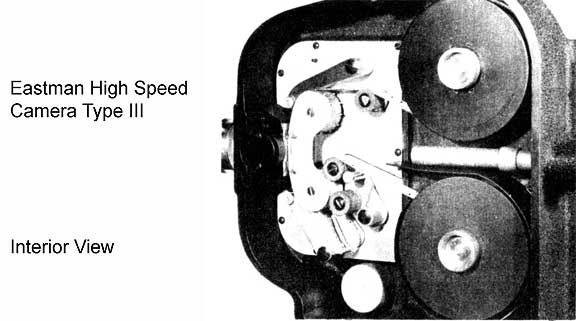 Optical compensation for continuous film movement: To obtain a clear, unblurred picture on each frame, it is essential that the image formed by the lens remain stationary on the film during the exposure period. This is accomplished by moving the image optically at the same speed and in the same direction the film travels, so that film and image are stationary in relation to each other during the brief period of exposure. This phenomenon of causing the image to move with the film is brought about by a rotating optical glass plate placed between the camera lens and the film. Synchronized movement of the shifting image and the continuously moving film is assured by having the rotating plate geared to the film moving mechanism. For those interested in more details about optical compensation for film movement, a schematic presentation with explanation is given on the following page. Lenses: The camera is equipped with an adapter so that lenses of various focal lengths can be used; this makes it possible to cover various field sizes from the same camera position. The f/2-7, 2 1/2-inch lens at its minimum focusing setting covers an area 1 1/4 x 1 inch (camera-subject distance 11 3/4 inches) and the f/2-7, 4-inch lens at its minimum focusing setting, an area 1 3/4 x 1 1/3.inches (camera-subject distance 24 1/4 inches). These lenses are Kodak Anastigmats of the highest quality, specially adapted for the Eastman High-Speed Camera Type III. Warning: Other Kodak Anastigmat lenses may fit the adapter, but their back-extension may interfere with their proper working; therefore no attempt should be made to use them on this camera. in the Eastman High-Speed Camera Type III 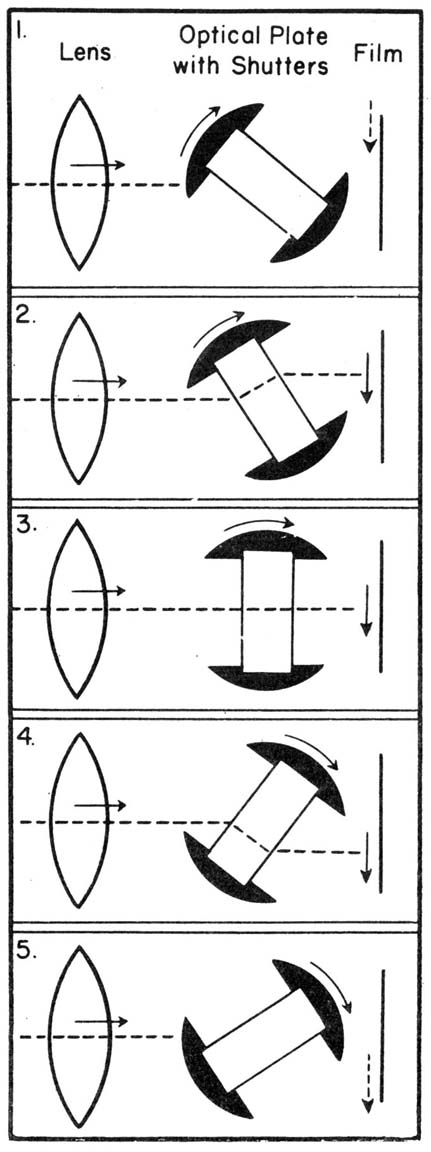 The image-forming light ray entering the lens from the left
is prevented from reaching the film by opaque end parts acting as a shutter.
(Figure 1)
The image-forming light ray entering the lens from the left
is prevented from reaching the film by opaque end parts acting as a shutter.
(Figure 1)As the shutter and optical glass-plate rotate, the light enters the glass plate. Due to the angle at which light enters, it is refracted upward. Upon leaving the glass plate, the light is bent again and so reaches the film at the top. (Figure 2) As the optical plate rotates, the angles of entry and exit of the light, and consequently the degree of displacement, become less until the glass plate reaches an exact vertical position, at which point, the light ray passes without deflection. (Figure 3) As the plate continues to rotate, the angles of entry and exit of the light become greater with the result that the image continues to be shifted downward (Figure 4) until the shutter cuts off the light ray. (Figure 5) As the image shift is continuous and at the same rate of speed and direction as the-film movement, a relatively stationary image is produced for a brief period of time, Note: For clarity's sake, only one ray of light is shown to illustrate the principle of optical compensation for continuous film movement. Definition: The optical system, consisting of lens and rotating optical glass plate, produces well-defined pictures. Their clearness and brilliance, however, cannot meet fully the standard of conventional 16-mm. Cine'-Kodak movies since the rotating plate introduces aberrations. Properly focused and exposed pictures are clear and reveal considerable detail. Focusing and Framing: For critical focus and for the determination of the exact field size, an optical direct-vision finder is provided. The image of the subject can be focused visually on a piece of surface-ground-film that is inserted into the film gate before loading the regular film into the camera. Film Used: The camera accommodates 50 and 100-foot Cine Kodak 16-mm. film spools. These films are available practically everywhere in various types of black-and-white and full-color Cine'-Kodak Films. The price of the film includes processing to a positive ready for projection. Driving Mechanism: The power for driving-the film, optical plate, and film take-up spool is provided by a dynamically balanced, 1/5 hp 32-volt universal motor. By overloading the motor in applying up to 115 volts, the speed is in creased over the normal rating. Since the motor is over loaded for only a few seconds at a time, no damage is caused by this method of obtaining rapid acceleration and maximum speed. The motor shaft and the principal shafts in the camera run in ball bearings of the highest quality to obtain maximum speed with virtually no vibration. Speed Range and Control: The motor is connected directly with the film-moving mechanism of the camera, and consequently the voltage applied to the motor controls the number of frames or exposures per second. At 32 volts the camera makes about 500 pictures per second, and at 115 volts, approximately 3000 after acceleration. If the motor is connected to a line voltage higher than 32, a stop on the built-in rheostat dial can be set to control the resistance left in the circuit. The voltage reaching the motor and consequently its speed can be controlled within a relatively close range. Acceleration of the Film: Motion-picture film is relatively fragile, and an excessive degree of acceleration would be almost certain to cause tearing and consequent failure. Excessive acceleration is avoided by introducing a variable resistance into the motor circuit. This rheostat is mechanically coupled to the motor, so that a predetermined portion of the resistance is gradually eliminated; this causes the motor to reach the selected speed at a rate be low the limiting value at which the film will rupture. At maximum speed settings, this acceleration may require 25 feet of film before the camera reaches approximately 80% of the desired speed. 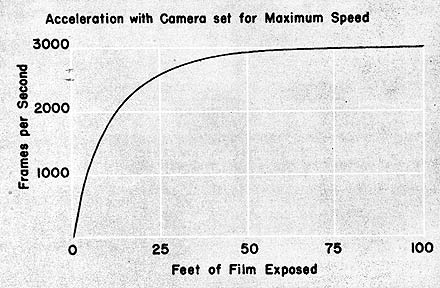 Auxiliary Switch and Coupling: This feature is provided to close or o-pen an external circuit after any predetermined length of film has been run. It can be used in synchronizing actions being photographed by the camera. Measuring Speed with the Eastman High-Speed Camera This camera is intended primarily for recording optically the behavior of fast moving objects for analysis and study at greatly reduced speeds. The rate of movement can be calculated within a fair degree of accuracy by noting! The number of pictures per second and by measuring the movement of the subject from one frame to the next or during several frames. A more reliable timing can be obtained by including in the field photographed an argon lamp operating on alternating current. By counting the number of frames that are needed to record one complete cycle, an exact picture frequency for measuring purposes is obtained. Viewing the Film The film properly exposed in the Eastman High Speed Camera Type III can be viewed with any good 16-mm. projector, such as a Kodascope. A high-wattage lamp
(750-watt) in the projector, provision to reverse the film direction,
and a still-frame feature are useful for the study of individual frames
for a short time. For some studies these features are indispensable. If
desired, photographic enlargements can be made from individual frames
for record or report purposes.
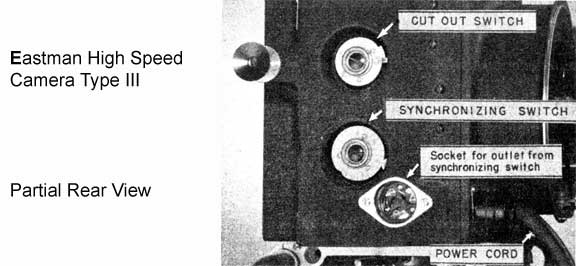 Summary
This new high-speed motion-picture camera is based on more than 19 years' experience in making high-grade 16-mm. Cine-Kodaks and 10 years in making high-speed 16- mm. motion-picture cameras. The Eastman High-Speed Camera Type III combines compactness and simplicity in operation with a sufficiently high picture frequency to make the instrument really useful for a wide variety of applications in the field of industrial design and production. Bibliography on High-Speed Motion Pictures Dealing Primarily with Their Application to Industrial Design and Production High-Speed Motion Pictures Aid Design J. R. Townsend, Electrical Engineering, a, 448-450, Nov. (1940) Stopping Motion for Design Data Kennbth D. Moslander, Machine Design 12, 51-54, June (1941) High-Speed Motion Picture Photography Applied to Design of Telephone Apparatus W. Herriott, J. Soc. Mot. Pict. Eng. 20-, 30-37, (1938) High Speed Motion Picture Photograph Applied to the Study of Machine Performance E. M. Watson, Product Engineer, 11, 340-343 Aug. (1940); Machinist 84, 500E-12E,- Feb. (1941) Tools Seen in Slow Motion L. T. Weller and E. M. Watson, Am. Machinist 85, 689-692, (1941) Aids for Analysing High-Speed Action E. M. Watson, General Electric Review 44, 549-557, Oct. (1941) High-Speed Motion Pictures in Industrial Development H. I. Day, J. Brit. Inst. Cinematog. 4, 15,25, Apr. (1936) High-Speed Photography and the Study of Machine Motions F Sepavich and A. Palmer, Mech. Engr. 62, 519-524 July (1940) High-Speed Photography and its Applications to Industrial Problems E. D. Eyles, J. Sci. Instruments 18, 175-184 Sept. (1941) The Stroboscope and High-Speed Motion Picture Cameras as Research Instruments. H. E. Edgerton and K. J. Germeshausen, Trans. Americ. Inst. Chem. Engr. 30, 420-427, (1934) Are Studies with a High-Speed Camera Anon., Brit. J. Phot. 85, 362, June (1938) High Frequency Photography and Aircraft Design Anon. Brit. J. Phot. 85, 809, Dec. (1938) Ultra-Slow-Motion Photography as Applied to Chemical Engineering Studies G. J. Esselen and J. G. Hildebrand, Trans. Am. Inst. Chem. Engr., 32, 557-565 (1936) Chips Form and Fall in Slow Motion Y. J. Bruce, American Machinist 82, 886-887 Oct. 5 (1938) Shutters and Cutters High-speed motion-picture photography used in the study of machine-tool cutting edges. B. L. McKenzie, Scientific American 166, 60-62 Feb. (1942) Effect of High-Intensity Arc upon 35-mm. Film Projection A study largely based on findings obtained by high-speed motion-picture photography. E. K. Carver, R. H. Talbot, and H. A. Loomis J. Soc. Mot. Pict. Eng. 41, 69-87 July (1943) Fast Motion Analysis as an Aid to Organized Invention Captain E. M. Watson, Air Corps, Armament Laboratory, Wright Field, Dayton, Ohio. Business Screen Magazine, Issue 6, 18, 19, 30, 31, 33, April (1944) Additional references to publications about the theory and practice of high-speed photography and its applications to fields other than those mentioned above will gladly be supplied by the Sales Service Division of the Eastman Kodak Company, 343 State Street, Rochester 4, New York Due to the present unusual difficulty in the supply of certain essential materials, and in precision production generally, deliveries of some of the products listed may be unavoidably delayed. For similar reasons, some of the equipment illustrated and described may undergo mild structural changes, without material impairment, however, of the product's efficiency. Printed by Eastman Kodak Company in September 1944 |